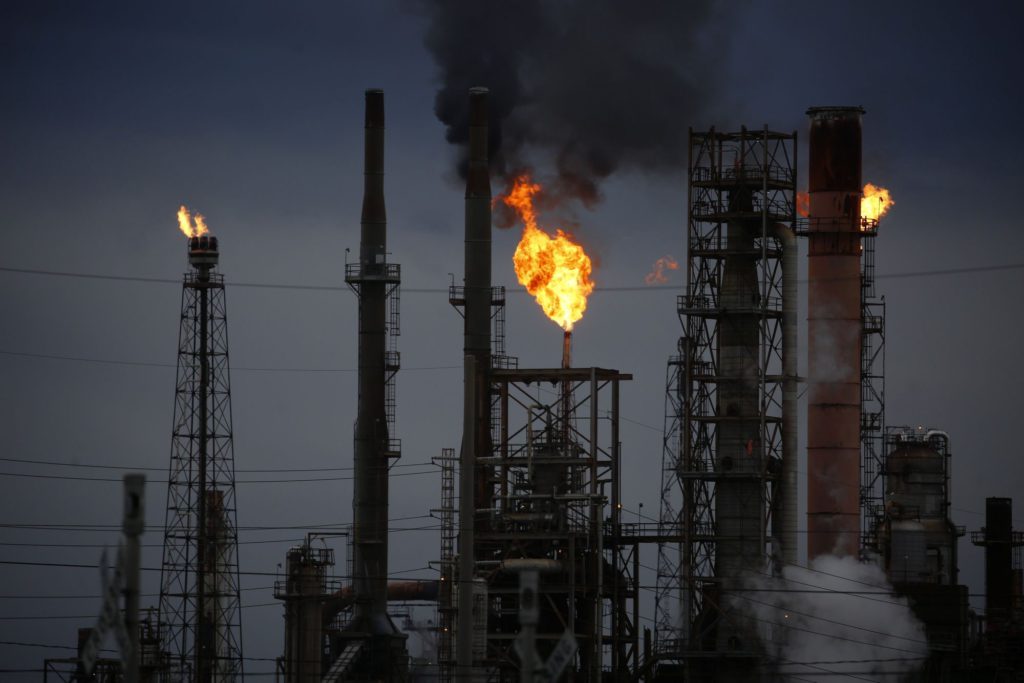The cold snap that froze Texas late last month resulted in the release of more than 1,000 metric tons of excess pollutants into the atmosphere.
(Bloomberg) — The cold snap that froze Texas late last month resulted in the release of more than 1,000 metric tons of excess pollutants into the atmosphere.
While it isn’t yet clear what exactly led to the unusual emissions, the state’s sprawling fossil-fuel and petrochemical industry is known to be vulnerable to unusually low temperatures, which can freeze natural gas lines, cause valves to seize up and disrupt power supplies. Industrial companies in Texas are required to report the events to regulators but aren’t generally punished for issues considered unavoidable. Communities near heavily-polluting facilities often feel the impacts most vividly, and incidents could increase over coming years as climate change spurs more volatile weather.
Emissions of gases such as carbon monoxide, butanes and sulfur dioxide exceeded norms by about 2.4 million pounds (1,089 metric tons) from Dec. 21 to Dec. 26, according to an analysis of preliminary data carried out by the advocacy group Environment Texas. Almost a fifth of that total came from Saudi Aramco’s Port Arthur refinery, the largest such facility in the US.
The state doesn’t track excess emission events over time, making comparisons with other periods difficult. But it’s clear the releases during the recent freeze — when temperatures fell as low as 11 degrees Fahrenheit (negative 12 C) in Dallas — were significant and “more than we see in some months,” said Michael Lewis, a researcher for Environment Texas.
During last month’s freeze, six facilities emitted more than 100,000 pounds of pollutants, five of them complexes along the Gulf Coast. About 90,000 people live within five miles of the top five emitting facilities, Lewis said.
At the Port Arthur refinery, an unexpected shutdown of several refinery units from the winter weather led to the release of 418,100 pounds of pollutants, including carbon monoxide, nitrogen oxides and sulfur dioxide, the company told Texas regulators. Other major incidents include a release of 279,320 pounds of pollutants by a large Chevron Phillips Chemical Co. plant when restarting units in preparation for the forecast freeze, as well as the release of 187,440 pounds of pollutants from the Deer Park oil refinery owned by Petroleos Mexicanos.
Motive Enterprises LLC, the operator of the Port Arthur refinery, didn’t respond to a request for comment. Chevron Phillips Chemical said it secured its facilities impacted by the freeze and provided accurate emissions estimates to regulators but didn’t answer questions about why it happened and how the company will prevent such emissions going forward. Petroleos Mexicanos didn’t respond to a request for comment.
If state regulators determine that the releases are the result of negligence or malfeasance, they can pursue penalties through an administrative order or a civil suit brought by the attorney general. Companies can take corrective action to avoid penalties and they can appeal any enforcement action. The state’s environmental regulatory agency may or may not assess penalties after the investigations conclude, an agency spokesperson said.
Analysts cautioned that the emissions numbers are subject to change as more data become available. After the Texas winter storm of February 2021 — a much more lethal event for the state, leaving hundreds of people dead after several days of power outages — officials drastically underestimated the emissions that were released, Lewis said. Industrial facilities released about 3.5 million pounds of excess pollutants tied to that event, according to an analysis by Environment Texas and others.
“What is surprising is that the numbers are that close,” Lewis said. The 2021 freeze “was just a much stronger storm lasting about a week with widespread snow and statewide outages lasting much longer.”
–With assistance from Amy Stillman.
More stories like this are available on bloomberg.com
©2023 Bloomberg L.P.










